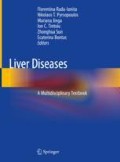Abstract
The abnormal accumulation of peritoneal fluid in the abdomen is a frequent complication in patients with cirrhotic and non-cirrhotic portal hypertension which is defined as ascites whose appearance heralds worsening of prognosis in such chronic diseases of the liver. Ascites can be also associated with acute liver failure, hepatic and extra-hepatic malignancies, infections (among them tuberculosis), pancreatitis, malnutrition or malabsorption or other rare inflammatory conditions. Therefore, peritoneal fluid analysis is mandatory to differentiate these clinical conditions in order to guide the best clinical management and treatment. This chapter summarizes the most important principles of peritoneal fluid analysis to best differentiate the etiological diagnosis of ascites.
Access this chapter
Tax calculation will be finalised at checkout
Purchases are for personal use only
References
Runyon BA, AASLD Practice Guidelines Committee. Management of adult patients with ascites due to cirrhosis: update 2012. Hepatology. 2013;57(4):1651–3.
European Association for the Study of the Liver. EASL clinical practice guidelines for the management of patients with decompensated cirrhosis. J Hepatol. 2018;69(2):406–60.
Wong F. Management of ascites in cirrhosis. J Gastroenterol Hepatol. 2012;27(1):11–20.
De Gottardi A, Thévenot T, Spahr L, et al. Risk of complications after abdominal paracentesis in cirrhotic patients: a prospective study. Clin Gastroenterol Hepatol. 2009;7(8):906–9.
Hemostatic balance in patients with liver cirrhosis: Report of a consensus conference. Under the auspices of the Italian Association for the Study of Liver Diseases (AISF) and the Italian Society of Internal Medicine (SIMI). Dig Liver Dis. 2016;48:455–67.
Uddin MS, Hoque MI, Islam MB, et al. Serum-ascites albumin gradient in differential diagnosis of ascites. Mymensingh Med J. 2013;22(4):748–54.
Kim JJ, Tsukamoto MM, Mathur AK. Delayed paracentesis is associated with increased in-hospital mortality in patients with spontaneous bacterial peritonitis. Am J Gastroenterol. 2014;109(9):1436–42.
Cavazzoni E, Bugiantella W, Graziosi L, et al. Malignant ascites: pathophysiology and treatment. Int J Clin Oncol. 2013;18:1–9.
Farias AQ, Silvestre OM, Garcia-Tsao G, et al. Serum B-type natriuretic peptide in the initial workup of patients with new onset ascites: a diagnostic accuracy study. Hepatology. 2014;59(3):1043–51.
Guillaume M, Robic MA, Péron JM, et al. Clinical characteristics and outcome of cirrhotic patients with high protein concentrations in ascites: a prospective study. Eur J Gastroenterol Hepatol. 2016;28(11):1268–74.
Riker D, Goba D. Ovarian mass, pleural effusion, and ascites: revisiting Meigs syndrome. J Bronchol Interv Pulmonol. 2013;20(1):48–51.
Field Z, Zori A, Khullar V. Malignant peritoneal mesothelioma presenting as mucinous ascites. ACG Case Rep J. 2018;5:e23.
Chauhan A, Patodi N, Ahmed M. A rare cause of ascites: pseudomyxoma peritonei and a review of the literature. Clin Case Rep. 2015;3(3):156–9.
Khalid S, Asad-Ur-Rahman F, Abbass A, et al. Myxedema ascites: a rare presentation of uncontrolled hypothyroidism. Cureus. 2016;8(12):e912.
Karlapudi S, Hinohara T, Clements J, et al. Therapeutic challenges of pancreatic ascites and the role of endoscopic pancreatic stenting. BMJ Case Rep. 2014; https://doi.org/10.1136/bcr-2014-204774.
Lizaola B, Bonder A, Trivedi HD, et al. Review article: The diagnostic approach and current management of chylous ascites. Aliment Pharmacol Ther. 2017;46(9):816–24.
Author information
Authors and Affiliations
Corresponding author
Editor information
Editors and Affiliations
Exercises
Exercises
1.1 Case 1
Sixty-eight years old man, recent 5 kg weight gain and abdominal distension. In medical history: diabetes mellitus for 3 years, hypothyroidism treated, no history of liver disease.
-
Blood Tests: AST 87 U/L; ALT 56 U/L; total bilirubin 1.4 mg/dL; albumin 3 g/dL; pCHE 1388 U/L, INR 1.31, creatinine 0.65 mg/dL. Anti HCV Ab positive, HCVRNA positive, normal TSH test.
-
Abdominal US: Ascitic fluid, small-sized liver, no focal lesions, portal vein 17 mm, splenomegaly (15 cm).
-
Diagnostic paracentesis:
-
Clear fluid
-
Liquid analysis: WBC 110/mm3, albumin 0.8 g/dL, total protein 1.1 g/dL, amylase 38 mg/dL, LDH 73 U/L, glucose 10 mg/dL ➔ SAAG 2.2 g/dL
-
Aerobic and anaerobic fluid culture: negative
Diagnosis: ascites in previously unknown HCV-related cirrhosis.
-
1.2 Case 2
Fifty-one years old woman, abdominal distension and pain. In medical history: breast cancer 8 years before (surgery, radiotherapy and chemotherapy).
-
Blood Tests: AST 14 U/L; ALT 12 U/L; total bilirubin 0.2 mg/dL; albumin 3.9 g/dL; pCHE 6974 U/L, INR 1.03, creatinine 0.76 mg/dL. Anti HCV Ab negative; HBsAg negative, CA 15.3 1287 U/mL (<34 U/mL).
-
Abdominal US: Ascitic fluid, regular liver, no focal lesions, portal vein 9 mm, spleen regular.
-
Total body CT scan: lymphadenomegaly (chest and abdomen, diameter max 4 cm) abundant ascites, suspected peritoneal carcinomatosis
-
Diagnostic paracentesis:
-
Blood fluid
-
Liquid analysis: WBC 192/mm3, albumin 3.1 g/dL, amylase 47 mg/dL, LDH 106 U/L ➔ SAAG 0.8 g/dL
-
Aerobic and anaerobic fluid culture: negative
-
Cytology: positive for atypical cell (suspected malignant cells)
Diagnosis: malignant ascites in metastatic breast cancer.
-
Rights and permissions
Copyright information
© 2020 Springer Nature Switzerland AG
About this chapter
Cite this chapter
Tosetti, G., La Mura, V. (2020). Peritoneal Fluid Analysis. In: Radu-Ionita, F., Pyrsopoulos, N., Jinga, M., Tintoiu, I., Sun, Z., Bontas, E. (eds) Liver Diseases. Springer, Cham. https://doi.org/10.1007/978-3-030-24432-3_37
Download citation
DOI: https://doi.org/10.1007/978-3-030-24432-3_37
Published:
Publisher Name: Springer, Cham
Print ISBN: 978-3-030-24431-6
Online ISBN: 978-3-030-24432-3
eBook Packages: MedicineMedicine (R0)

